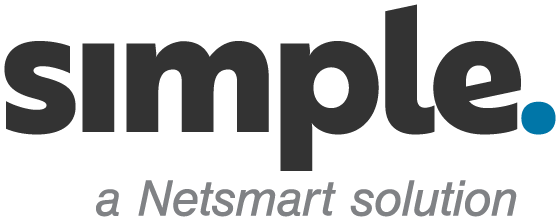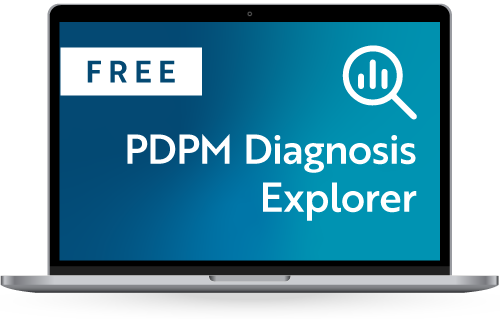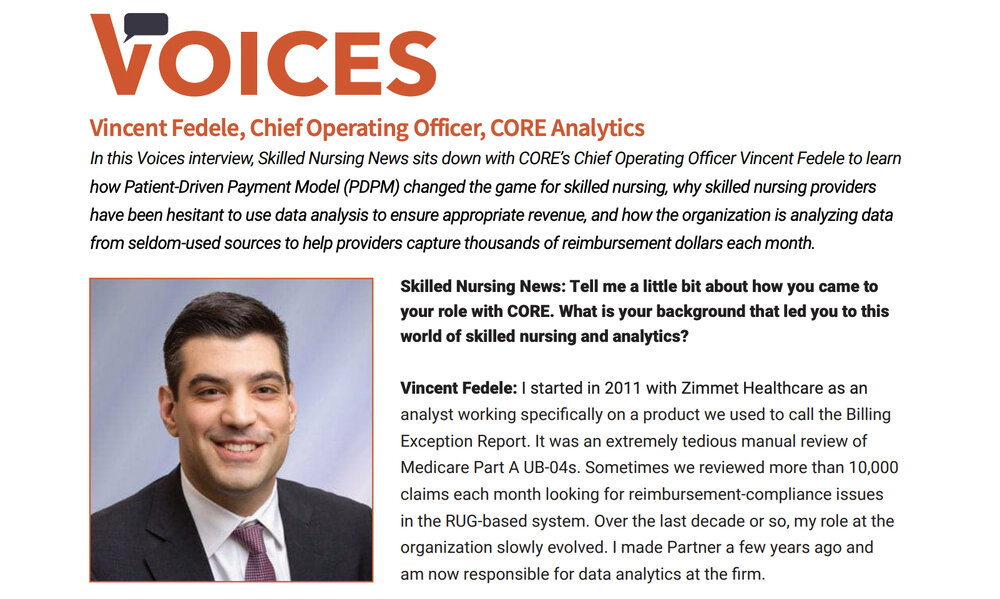How long has CORE Analytics been around? What was the background?
We got the idea from the convergence of two unrelated factors. One, we got a call from one of our Zimmet clients saying he was very excited that he had just signed up for a service to receive two-year-old Medicare claims data. He was paying an astronomical fee for it. Two, at the same time, CMS released the blueprint for PDPM, which at the time was RCS. We realized that there was an unmet need for current claims data both on the market analytics side as well as the reimbursement analysis side. That’s what led us to create CORE, which is truly a new product class. There’s nobody else in the industry doing what we are doing with our source document, the UB-04.
We officially launched the market analytics portion in 2018, and the PDPM functionality began in 2019, which is essentially the automation of our long-standing Billing Exception Report that we had done manually for 15 years. The difference is that the product was more of a compliance product under the RUG-based system. When we saw the early blueprints for PDPM, we realized that there could be tremendous reimbursement opportunity and a high return on investment for the providers with our claims-based approach due to the way that the new system was structured.
Where do you see skilled nursing providers as most challenged when it comes to their data collection and analysis?
I group this into four main categories, the first of which is data overload. Some companies throw so much data at the wall that it becomes somewhat confusing or even unreliable, and the provider ends up not using it. The next is lack of standardization. We see a lot of data that has issues with “comparative integrity” — not comparing apples to apples, trying to gain insights from two data sets that are not comparable. Another one is issues with integration — and that’s costly in terms of both time and money. Then fourth, the data is often outdated. We classify all of these as “technology fatigue,” which at the end of the day ends up meaning providers are paying for technology and data applications that they’re just not using to the fullest potential.
What’s the greatest opportunity that skilled nursing providers can gain from this type of data collection and analysis? How does CORE help with that?
There’s an important distinction to make between data and information, and what we try to focus on, which is actionable intelligence. We are looking for those subtle statistical differences that can add up to $40 or $50 per patient day, which when extrapolated across an entire network, can result in a significant reimbursement increase.
Our data source is probably the most underappreciated document in the entire reimbursement process. There’s been so much emphasis placed on the MDS (minimum data set) and the EMR (electronic medical record), when the truth is, there are going to be items that only appear on the Medicare claim that can point us in the direction of lost reimbursement. CORE was designed to pick up on those 15% or 20% of items that were missed elsewhere in the process that appear on the claim, and nowhere else, that can help the provider appropriately improve their capture.
Could you specify on the data points themselves that are most helpful or things that you would like to see that don’t exist yet that would be helpful to providers and policymakers?
I think providers can most benefit from the subtle data points that direct them to lost revenue opportunities and compliance issues, which we seek to identify in our logic testing that focuses on the Medicare claim. Policymakers should really be focused on, in my opinion, creating a standard mechanism to account for local differences that are made by national policy initiatives. The skilled nursing industry is not a national industry. Each state is distinct and sometimes even within a region in a state the operating environment is very different. Any data analysis needs to take that into account to ensure comparative integrity.
Why do you think nursing homes have been reluctant to invest in data and other technology in the past?
I can answer that question by telling you the three mandates that we had in place before getting involved in the technology space. No integration. Painless onboarding. And no contract term. When we realized we wanted to get involved in the space we looked at 20 different products and each of them had one of these fatal flaws. When we built CORE, one of the most important things we wanted to do was not to integrate with any EMR system; it’s costly in time and money and it creates issues with standardized, meaningful and reliable data. For CORE, if you bill Medicare, and Medicare pays you, then you have exactly the document that we need. Many of our clients don’t even have an EMR. Without any exaggeration, I tell you that our onboarding process takes less than five minutes, so there are no integration fees or unnecessary delays. There’s also no long-term commitment. In comparison, I read a contract the other day for a technology service provider that locked a nursing home into a three-year commitment for a relatively standard and basic service. When we created CORE, those were the three necessary requirements to be successful and meet the needs of the industry we serve.
What are you, in your view, what do providers need to look at now with respect to their benchmarking, now that PDPM is in place? What has changed?
We went from a payment system with RUGs that had essentially two distinct components that determined your success with the system: The level of therapy and ADL score. Fast forward to October 2019, and now we literally have hundreds of elements that need to be tracked to be successful with PDPM. The challenge is that no industry standard exists. One of our principles, and one of the things that we knew we had to do, was to create our own industry standard through our proprietary database of claims, and that’s exactly what we did. The other thing providers should be looking at is ensuring that apples-to-apples comparison. We used to be able to look at two nursing homes in the same market, and the provider that had the higher Medicare rate was doing better at managing that system; they were getting a higher level of ultra-high capture. That is just not the case anymore with PDPM because of the variable per diem schedule. A nursing home with a shorter length of stay will often have a higher Medicare rate than a nursing home with a longer length of stay, and if you compare the two, it doesn’t necessarily mean that the SNF with the higher rate is doing better than the other with PDPM. The opposite could actually be true.
Has PDPM had the impact that you expected it to have? What did you expect?
Yes, it has had the impact on providers that we expected. We were very vocal about the upside potential and the revenue potential months and months before the payment system was released live. The thing that I’ve been surprised by or shocked by has been how much money is still being left on the table despite the general perception in the market that the revenue upside is positive. In our claims analysis for our clients, we’re finding another $12 to $14 per Medicare day — things that can be fixed prior to billing. These can be easy things, such as common mistakes due to process issues, staff education, putting the wrong code in the wrong spot, not being specific enough with coding, and workflow challenges. The record in recovered reimbursement we’ve seen right now is $80,000 saved for one month of billing after analysis by CORE, which we joke pays for the product for the next 20 years for that SNF.
Where does CORE go from here? Is there anything that you can share as to what’s coming up ahead?
Our main goal is to be the standard for post-acute care analytics in the industry. I would say that the analytics market for postacute care is ripe for disruption, but there’s really nothing to disrupt. It’s very bare-bones, and our sole focus is creating products and services that improve on this gap and unmet need for improved post-acute care analytics. We seek to further our initiative in leveraging information in a way that is meaningful and reliable for all skilled nursing facility stakeholders.




